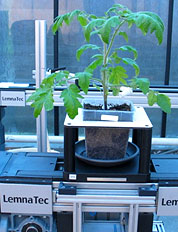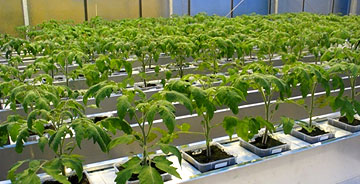|
The Green Gene Revolution: tasty food, every day
LemnaTec GmbH and Keygene N.V. collaborate in crop breeding
 |
|
The
author,
Harold Verstegen,
is Vice President,
Bioinformatics
Keygene N.V. |
|
November 2010
Yield, stability, quality and shelf life of fruit and vegetables
are some of the major challenges for breeders. Yet, consistent
quality of taste, color and texture cannot be guaranteed for
products we buy at the natural and organic produce retailer, at
farmers’ markets, and in supermarkets. When such a guarantee can
be provided, it will have a high impact on product sales,
consumer satisfaction and the environment — resulting in more
efficient use of food crops, less waste and higher
profitability.
The importance and advantages of automated phenotyping
 In
the plant breeding industry phenotyping is one of the In
the plant breeding industry phenotyping is one of the
most
crucial aspects of variety development. Phenotyping
is laborious
and requires the significant experience of a professional
breeder. Also, the high complexity of agronomically important
traits makes it difficult to perform phenotyping with high
throughput.
In 2007, KeyGene decided to invest in a new digital phenotyping
technology called KeyTrack™, for high throughput screening of
phenotypic variation. Through digital phenotyping it is possible
to link complex traits to the available data of the DNA of
varieties. This results in finding the gene of interest and the
location of such a gene. For example, it was possible to
identify a color gene in pepper by combining KeyGene’s existing
DNA technology with automated phenotyping. Breeders will benefit
from these capabilities by finding genes linked to certain
traits, resulting in better breeding material and in consumers
enjoying fresher and tastier products.”
 The KeyTrack platform is a robust phenotyping platform in a
greenhouse setup. The phenotyping is based on imaging technology
and uses the potential of a fully automated track that moves all
plants through the greenhouse compartment and scanning areas.
The plants grow in individual containers and are photographed at
preset points in time and from various angles. The images are
stored in a large database, ready for further detailed trait
analysis. It is possible to look at typically dissected traits
such as shape, color, architecture structure, leaf area and
water content. With these data projects like biomass
development, yield stability, root development, shoot
development, drought experiments and resistance screening can be
carried out. The KeyTrack platform is a robust phenotyping platform in a
greenhouse setup. The phenotyping is based on imaging technology
and uses the potential of a fully automated track that moves all
plants through the greenhouse compartment and scanning areas.
The plants grow in individual containers and are photographed at
preset points in time and from various angles. The images are
stored in a large database, ready for further detailed trait
analysis. It is possible to look at typically dissected traits
such as shape, color, architecture structure, leaf area and
water content. With these data projects like biomass
development, yield stability, root development, shoot
development, drought experiments and resistance screening can be
carried out.
Joint forces to add capabilities for breeders
LemnaTec, a German technology company, and KeyGene are
collaborating in plant “phenomics.” By combining the strength of
LemnaTec’s imaging platform and KeyGene’s analysis platform new
high-throughput capabilities for robust and objective screening
of plant populations can be offered. KeyGene and LemnaTec will
be the first in Europe to deliver this technology as a service
for customers all over the world.
For more information, please contact:
Harold Verstegen, VP Bioinformatics,
hve@keygene.com
|